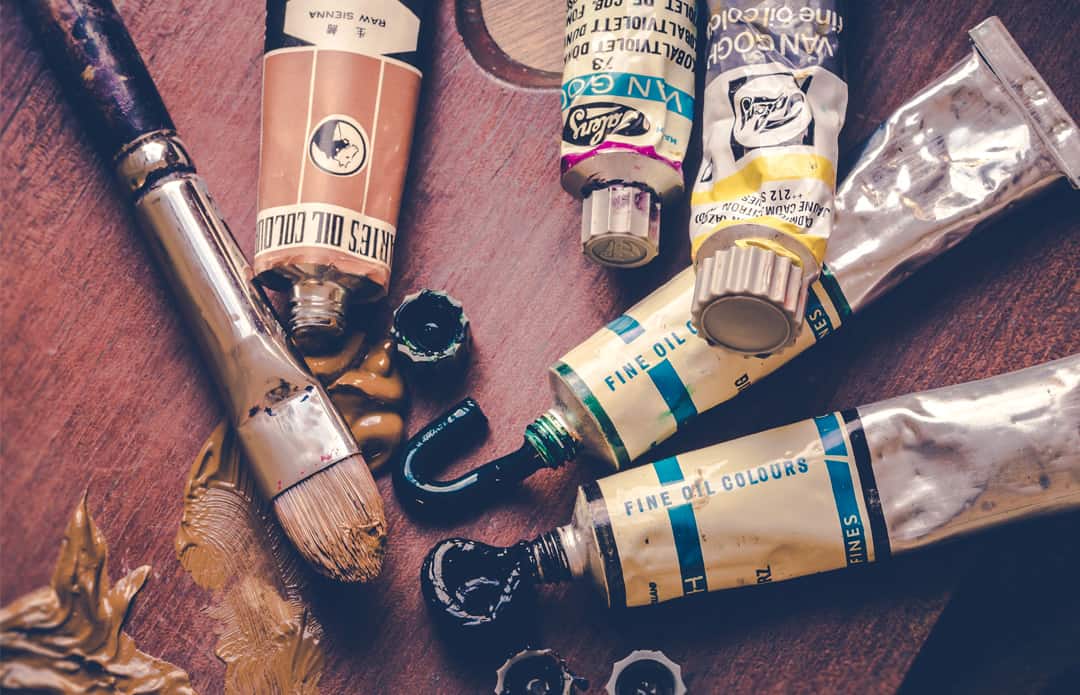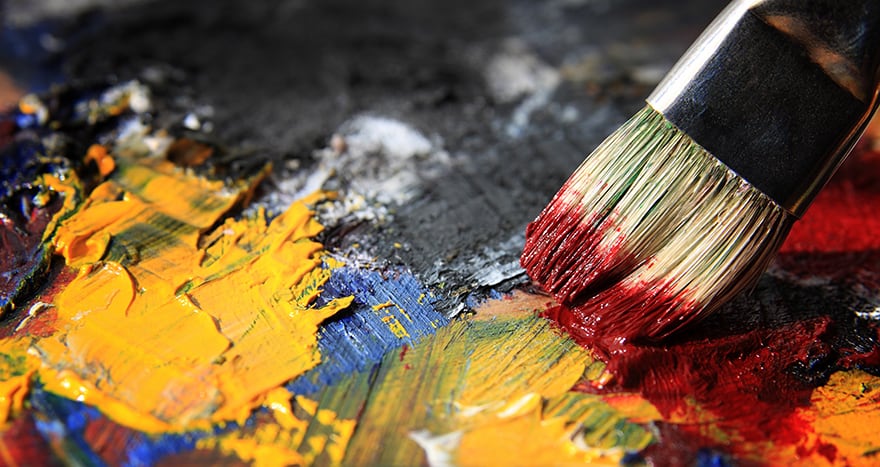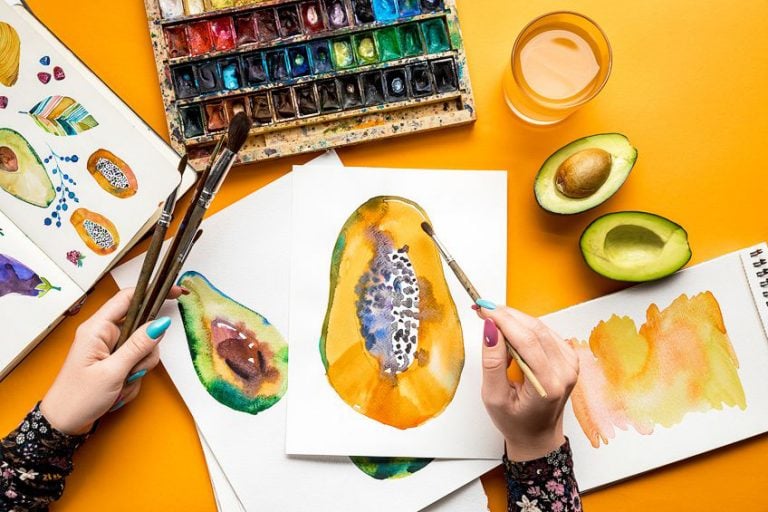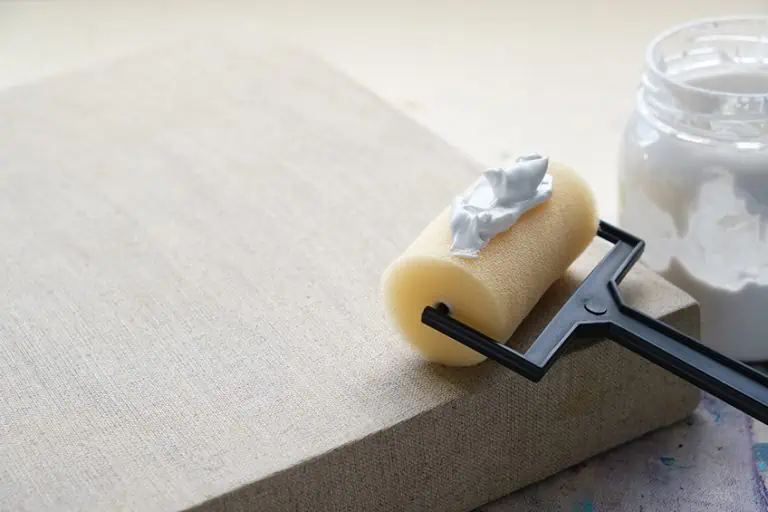Oil Painting Mediums Overview – Best Medium for Oil Painting
This post may contain affiliate links. We may earn a small commission from purchases made through them, at no additional cost to you.
Oil paint mediums seem to be very mysterious, which causes a great deal of confusion and uncertainty as to their actual uses and properties. Many artists never use a medium when first starting, but once they are fully understood, they begin to make use of these mediums all the time. Oil mediums are used by professional artists as well as beginners, however, their use is not encouraged at schools. This is due to the stains and messes the oil mediums can cause. In this article, we will try to help you understand the properties of oil paint mediums, where to use them, and also what mediums are best for your particular project.
Table of Contents
- 1 What is an Oil Paint Medium?
- 2 Painting Mediums that Change the Transparency of Your Oil Paints
- 3 Painting Mediums that Change the Drying Time of Your Oil Paints
- 4 What Painting Medium Should you use?
- 5 Solvents as Paint Mediums
- 6 Cold Wax as Paint Mediums
- 7 Alkyd Resin as Paint Mediums
- 8 Comparison Chart
- 9 When to Use Oil Paint Medium
- 10 Oil Painting Mediums Recipes
- 11 Frequently Asked Questions
- 12 Conclusion
What is an Oil Paint Medium?
An oil paint medium is a liquid, that when you add it to your paint, will change its performance in some way or another. An oil medium is specially designed to alter the oil paints’ drying time, viscosity, and also transparency, as well as allowing the paint to go further. When you use different types of mediums, you will have different results. For example, some mediums speed up the oil paint drying time while others reduce the drying time. All of the oil paints already have mediums in their formulation before you add any yourself. The paint pigments are simply a dry-colored powder, to which oil is added and this serves to bind the pigments together.
By using an oil paint medium, you will be able to control your paint more. This means you can add diversity to your patterns, lines, marks, and textures, and expand your painting techniques by providing yourself with greater options and possibilities in your artwork. The oil mediums are a mixture of a few ingredients such as resins, drying agents, or oil and solvents. These can be used individually or as a combination of all or a few of them. By understanding what these mediums can accomplish will help you to choose the right one for your project. Let us now consider the effects that these mediums have on your paint in greater detail.
Painting Mediums that Change the Viscosity of Your Oil Paints
By using a painting medium on your oil paint, you will alter the characteristics of the paint. In other words, if your paint is fairly thick like butter which most oil paint brands in their tubes are, by adding the correct paint medium, you can make it either thicker or more liquid.

Increase Flow
If you need your paint to flow more fluidly for painting finer details, then by adding a medium, you can reduce the viscosity and make it thinner. This will enable you to manage the flow of the paint better. This process will allow you to create brushless, flat sections as your paint will level out. This process will also allow your paint to go further.
Increase Body
On the other hand, if you want the brush marks to stay or you want an impasto or thick paint texture, you will have to thicken your paint. This can be done by mixing a gel or wax medium with your oil paint, which will give you sharply defined knife ridges. You will be able to apply it with the use of a painting knife to your canvas.
Painting Mediums that Change the Transparency of Your Oil Paints
No matter what type of painting medium you use, they will all have some effect on the surface finish of your artwork. Your oil paint consists of pigments, oil, filler, and often also a drier. When you add anything more, you will naturally change how the paint looks once it has dried. By adding a medium you can create a matte finish, various ranges of satin sheens as well as a high gloss finish. When using painting mediums that contain wax, you can end up with a satin or a matte finish because the wax is regarded as a matting agent. If you are looking for high gloss look, you can use natural resin in your paint. However, using a synthetic resin, you will create a low gloss or low satin finish.
A good point to remember is that if you alter the viscosity of your paint, you will also automatically change the surface finish to a certain degree. Likewise, if you alter the transparency of the paint, you will also automatically change the viscosity to a certain degree. You cannot separate these two properties, what you do to the one will affect the other. The whole process all depends on the results you want.
Here is an interesting piece of information, if you have used a medium that alters the viscosity of the paint, but you are not satisfied with the resulting surface finish, then at a later stage, you can use some varnish to fix the problem. Varnish will create less or more of a gloss to the final surface finish of your artwork. This type of varnish is referred to as picture varnish and can be purchased with a matte or gloss sheen. When mixed with your paint, it will give you a range of satin finishes.
Painting Mediums that Change the Drying Time of Your Oil Paints
Various formulations used by different paint manufacturers will give it different drying times. When referring to artist-grade paints, then each color has its own drying time, as the quantity of oil and pigments that have been added differ for each color. You can vary the drying time of oil paints by adding mediums that will shorten the drying time by a few hours, or you can lengthen the drying time for several months.
For Slow Drying Times Use Fat Mediums
A medium that contains a high level of oil will take a longer time to dry, which will allow you more time to control your paint. These mediums are referred to as ‘fat mediums’. This is especially effective when you are painting in layers, the fat mediums are used in the middle layer and also in the final layer to give your color depth. It is not recommended that you paint over the fat mediums with lean mediums that are quick-drying, as the fat mediums tend to expand as it dries, causing the thinner layers that have already hardened to fall apart and result in a cracked paint finish.
For Fast Drying Times Use Lean Mediums
Lean or quick-drying mediums are used if you are after less open time for your paint to dry. Driers are often added to the paint to make this possible, together with large quantities of resins and solvents with a low quantity of oil. Depending on what ingredients you use, what your mixing ratio is, and what type of application you use, this type of lean medium can make your paint dry to the touch overnight. You can also add a very small amount of siccative medium to your paint to increase the drying time. If you are up to it, you can also make your own fat or lean mediums.

What Painting Medium Should you use?
As we have already discovered, the use of a medium can change the finish, drying time, and consistency of your paint. The type of paint medium you use, will all be dependent on what you want to do with your paint. You can mix the oil medium directly on your palette in the paint or you can dip the paintbrush into the medium just like you dip it into the water.
When deciding on what paint medium to use will depend entirely on what you want to achieve with your artwork. For instance, do you want to increase or decrease your drying time, do you want to change the surface appearance, or do you want to thin or thicken your paint? As soon as you have decided, you will be ready to choose the paint medium that will give you the result you are looking for. We will now be discussing what different types of painting mediums are available and what they can do for your artwork.
Oils as Paint Mediums
The properties of oils include increasing the flow and transparency of the paint, leveling your brush strokes, and slowing down the drying time. However, you cannot use all types of oil in your oil paints. There are a few oils that are commonly used for painting, which include linseed oil, with all its variations, poppy seed oil, walnut oil, and safflower oil.
All these oils are referred to as drying oils. There are a few other not-so-popular oils, which include tung, perilla, and soybean oils. Perilla oil tends to yellow as it dries, and tung and soybean oils do not provide an absorbent paint film. Let us now consider these oils in greater detail.
Refined Linseed Oil
This oil comes from the ripened, dried seeds of the flax plant and is often referred to as flax or flaxseed oil. This oil is most commonly used to create paint mediums, as it is unrivaled in durability compared to many other drying oils. The purpose of this oil is three-fold:
- To reduce the viscosity,
- Slow down the drying time
- Increase the gloss finish of your paint
Refined Linseed Oil has a low viscosity and will dry at a fairly slow rate. Linseed oil has a somewhat yellow color and tends to cause the yellowing of paint over time. This oil also contains small measures of linoleic and linolenic acid which makes it ideal for oil paints. Unfortunately, the linolenic acid can cause your paint to yellow, but it also forms an exceptionally durable strong paint film.
Best Oil Medium for Oil Painting: WINSOR & NEWTON
The Refined Linseed Oil from Winsor & Newton is one of the most popular of all their oils and has excellent reviews and is used by professional as well as beginners. By adding to other oils, you can slow the drying time down, but it does take time to dry properly. This is an alkali refined oil that has a low viscosity and will increase the transparency and gloss but reduces the color consistency of the oil. This paint medium is supplied in a 75 ml bottle.
- Refined linseed oil is the most commonly used oil by artists
- Add to other oils to slow drying, reduces oil color consistency
- Increases gloss and transparency
PROS
- Increase gloss and transparency
- Used by most artists
- Has a low viscosity
CONS
- Some users found the finish only lasts for a few months and then has to be reapplied
- One user struggled to remove the cap
- Reduces consistency of colors
Cold-Pressed Linseed Oil
Cold-pressed linseed oil has the purest natural oil grade than the solvent extracted or hot-pressed oils. It will give you a harder and more durable film that is more transparent with an increased gloss finish, and also reduces consistency. It has a slower drying time than refined linseed oil, which means it is dry to the touch within four days. Cold-pressed linseed oil is high-quality oil used as a binder in the manufacture of paints because of its high acid number.
Again, WINSOR & NEWTON come out on top, and their cold-pressed linseed oil is a popular Amazon choice product. This particular oil helps to increase transparency and gloss as well as improve paint flow. The oil will also help to reduce the number of visible brushstrokes and can be used to grind pigments.
- Is extracted without the use of heat and dries slightly quicker than refined linseed oil
- Improves flow, increases gloss and transparency, and reduces consistency and brushstrokes
- Ideal for grinding pigments
Linseed Stand Oil
This oil is a lot thicker than refined linseed oil and comes from flax and is similar to ordinary linseed oil. The main difference between these two oils is the method of treatment. Refined linseed oil is subjected to a high temperature, usually in a sealed chamber, and stand oil is formed by heating linseed oil at an extremely high temperature over a long period. This process causes polymerization of the molecular structure, forming thicker oil almost like that of honey, which will make it go a lot further than refined linseed oil.
Another great advantage of stand oil is that it gives you a beautiful glossy finish, which makes it ideal for glazing purposes. The oil is also a lot less prone to yellowing due to the reduction of oxidation, which is the main culprit for paint turning yellow.
This oil has amazing brush leveling properties but does not flow as well as refined linseed oil, which may result in dragging your paintbrush. Stand oil is also less likely to ‘sink in,’ a term used when the upper layer of paint is taken up into the lower layer. However, if you mix your stand oil with some turpentine, it will dry a lot quicker than refined linseed oil that has also been mixed with turpentine.
The GAMBLIN Stand Oil is a heavy oil with high viscosity that will give you an enamel-like finish. By adding this oil, you will be slowing down the drying time of the paint. You will also most likely experience wrinkling, which is a great effect if that is what you are looking for.
- High viscosity and moderate dry
- A heat-bodied – heavy oil that leaves an enamel-like finish
- Package contains one 8oz bottle of Linseed Stand Oil
- Country of Origin: United States
Safflower Oil
Safflower oil is also used as a binder in the manufacture of paints, as it contains little linolenic fatty acid, the substance that causes paint to yellow. Whenever you use this oil as a painting medium, you will find it has a lower viscosity than refined linseed oil which helps it to flow easier and spread further. Safflower oil also costs less than refined linseed oil and will dry slower, never really drying completely. In some cases, when left in extremely hot temperatures, the paint has started to melt. This oil has a lot weaker paint film and is not exceptionally durable at all. This has caused many to shy away from it as a painting medium, but if used very sparingly works extremely well.
A popular brand and product are the GAMBLIN Safflower Oil, which is slow drying and non-yellowing. Great for thinning your oil paints. Many have also found this oil the perfect alternative to mineral spirits and is a solvent-free brush cleaner.
- Gamblin Safflower Oil is lighter in color than linseed oil, non-yellowing, and slow-drying.
- It is an excellent medium for passages of white and other light colors, making them sparkle and pop.
- Safflower oil also makes an excellent solvent-free brush cleaner during painting sessions.
Poppy Seed Oil
Poppyseed oil is remarkably similar to safflower oil and is clear in color. This means it will not affect the color of your paint and is also a lot less prone to discoloration of your paint color over time. Some manufacturers have used it as a binder in their paints which helps them to keep the sharp hue of colors over time. The oil has a slower drying time than linseed and safflower oils and also improves the flow and gloss of the paint. As it contains little fatty acid, the paint film is not as durable and may tend to be slightly softer compared to linseed oil.
GRUMBACHER’S Poppy Seed Oil is smooth and helps to prevent paint pigments from yellowing. The oil offers many other benefits including, an increased drying time, evens brushstrokes, helps with the flow of paint colors, and also provides a great shine.
- The slow-drying medium used with oil paint, made in USA
- Especially good to use with pale colors, as it has excellent color retention
- Often used for alla prima (wet-in-wet) techniques
- It is not for use with multiple layer techniques
Walnut Oil
Walnut oil is an excellent alternative to use instead of linseed oil, as it will give you a more durable and flexible film than safflower or poppy oil. It is also durable and glossy and gives your colors greater depth The oil will slow down your drying time and improve the paint flow. Wherever you find a dry patch on your painting and the paint oil has seeped down into the bottom layers; then spreading a thin layer of walnut oil over the spot will restore the brightness of the colors.
Walnuts are cold-pressed producing the walnut oil and then refined. This oil dries much faster than poppy seed oil but is less durable than linseed oil, and you can mix it with linseed oil. Care needs to be taken when storing walnut oil, as it can become rancid if exposed to the air. Good advice is to store it in your refrigerator.
The M. GRAHAM Walnut Oil helps slow drying time and increase paint flow. Other benefits of the oil include, it is non-toxic, solvent-free and is also non-yellowing. For this reason, it will aid in retaining the vibrancy of the paint colors.
- Removes color from artists brushes without creating a solvent hazard
- The addition of walnut oil to color will increase flow and slow the drying
- Nontoxic and solvent free, non-yellowing nature retains brilliance of color
Solvents as Paint Mediums
Solvents are used when you have finished your painting and you want to clean your brushes and equipment, however, they can also be incorporated into your painting process. When solvents are used as paint mediums, it has certain properties that are evident. For example, it increases the paint flow, thins out the paint, speeds up the drying time, increases the transparency of the paint, and will also give your paint a matte finish.
Using solvents in your paints, the solvent rapidly evaporates from the surface in around 24 hours. This allows the pigments and the binder to oxidize. The solvent will also change the surface finish of your painting, leaving the colors dryer, duller, and very brittle. Therefore, we suggest that you use solvents to thin your paint in the early stages of your artwork that will not be seen once the painting is complete.
Try not to use too much solvent to thin your paint, as it may cause your paint to become chalky. When you use the thinned paint over oil-rich layers of paint the paint film will likely crack. To stop this from happening, remember the fat-over-lean rule, which we discussed earlier in this article concerning fat and lean mediums.
If you are a beginner with oil painting and you are not sure how to mix the solvents with your paint, try to start by blocking in colors by using only pigments and solvents. Then you can progress to a 1:2 oil to solvent ratio mixture and then to a 1:1 and eventually you can increase the oil in your mix for each layer. If you want to mix your oil painting medium, you can include some linseed stand oil or cold-pressed linseed oil.
Remember, the oil must be added to the solvent and not vice versa because the linseed oil is viscous and needs to be agitated when mixed. Now leave the medium mixture for 48 hours, allowing it time to combine properly. Let us now take a closer look at what solvent we can use in our paints as a medium.

Turpentine
Turpentine, often referred to as ‘Turps,’ is distilled using the pine tree’s resin and evaporates at an extremely fast rate. This solvent is the most compatible of all the solvents for use in your oil paints, and once combined with the pigments and oil of your paint will give you a perfect even finish. When purchasing your turpentine, you need to ensure you buy the refined grade especially for use in artist’s paints, as the ordinary turpentine bought in the hardware store has too many impurities that should never be mixed with your oil paints. The turpentine that is not distilled contains a gum residue that can easily cause your paint to yellow.
As turpentine has a very toxic vapor, it can be harmful to your health if breathed in. When using it as a medium, make sure to work in a well-ventilated area and wear protective equipment. Keep children and pets away from it and ensure that the caps are securely tightened when storing. Turpentine is durable and can be used over and over again. Simply allow the sediment to settle and you can use it again. If you are one of those people that do not want turpentine mixed with your paints, no problem, as many other alternative solvents are not as toxic.
Since artists work closely with their paint and turpentine can be strong in odor, the WEBER Odorless Turpenoid substitute may be a better option. The product offers a similar drying time and other painting properties to that of normal turpentine but without the terrible smell.
- Recognized by artists as the #1 odorless, volatile and thin turpentine substitute
- Same painting properties and drying time as turpentine
- Odorless - does not have the strong odor like turpentine has
- Compatible with oil and alkyd colors as a painting vehicle either alone or in mediums without affecting color
Odorless Mineral Spirits (Artist’s White Spirits)
This solvent is distilled from petroleum and is used to thin your oil paint colors. In the United States it is called odorless mineral spirits, but in the United Kingdom is referred to as White Spirits. It is less compatible with oil paints than turpentine, as it is a lot more abrasive and can break down your paint in an uncontrollable way. Therefore, it is advised, if you are going to use it to thin your paint you first mix it with another oil medium.
Best Solvent Paint Medium: U.S. ART SUPPLY
The Odorless Mineral Spirits brand is perfect for diluting or thinning your oil and alkyd colors and can be used like turpentine but without that unpleasant odor. The highly refined formulation helps blend and thin oil-based paints, varnishes, and stains and is excellent for blending colored pencil art.
- Premium highly refined solvent formula that effectively thins and blends well into oil-based paint, stain and varnishes.
- It can be used like turpentine with no unpleasant odor 125ml / 4.2 Fluid Ounce Container
- Excellent cleaner for paintbrushes, tools and equipment immediately after use of oil-based paint products
As it is odorless, you can use it indoors or outdoors. Also, because the strong odor has been removed, it is much more pleasant to work with. However, be careful when working with it because it is combustible and if swallowed can be harmful to your health. This is also an excellent product to use for cleaning your brushes and equipment and leaves a minimal amount of residue to clean up.
PROS
- Odorless no toxic fumes
- Blends paint easily
- Excellent product for cleaning brushes and equipment
CONS
- It is combustible
- Can be harmful if digested
Oil of Spike Lavender
In the past, this solvent was used as a substitute for turpentine. This oil is much stronger as a solvent than turpentine and can dissolve resins completely. The oil very easily breaks down thicker paint and also mixes extremely well with oil to produce a medium. This means that you will use a lot less when thinning your paint.
Another quality it has is it increases the adhesion with the layers of your oil paints. Also, it can improve the transparency of your painting and can extend the uniform particle dispersion. Another advantage is that it is a lot less toxic than turpentine with less strong fumes, some people even agree that it has quite a pleasant smell.
However, you must remember that it is still a solvent, and you need to treat it as such when working with it. Make sure to do so in a well-ventilated area and use the necessary safety equipment. Unfortunately, this is a lot more costly when compared to turpentine, but you only require a small amount, so it should go a long way.
The CHELSEA CLASSICAL STUDIO brand offers a spike lavender product that is a safer alternative to turpentine and provides a much better smell. A natural solvent that ahs been used for many years helping to thin paints and can be mixed with other oil paint mediums, varnishes, and resins.
- A natural solvent that thins oil painting mediums, resins, and varnishes.
- Has a distinctive, sweet lavender scent, and is a safer, natural alternative to Turpentine.
- Does not cause chronic health problems that are often associated with turpentine or odorless petroleum mineral spirits.
Cold Wax as Paint Mediums
This type of medium comes in the form of a thick paste and its properties include speeding up drying time, thickening your paint, giving your brushstrokes more texture, and leaving you with a matte finish. Cold Wax is more than just a paint medium, it is a complete style of painting called cold wax painting. This form of mixing the wax with your paint is referred to as cold waxing because it is not necessary to heat the wax.
Cold Wax will add transparency and luminosity to your painting, and you do not have to be shy with the amount of wax you add to your paint. Although, it is recommended that you use a mixing ratio of 1/3 cold wax to 2/3 oil, which will give you an impasto textured effect. Nothing is stopping you from mixing dry pigment with your wax and leaving out the oil altogether. However, if you do follow this process, make sure to add a small amount of alkyd as well to stop the layers of paint from cracking.
To paint with wax is fairly simple because the ‘fat over lean rule’ does not apply to prevent the paint from cracking. The process also helps to speed up the drying time to a few days if you have very thick layers of paint. The cold wax medium is formed when you combine solvents, beeswax, and resins, and often linseed oil. The solvent will then evaporate and allow the soft wax to harden.

Gamblin Cold Wax
Gamblin cold wax is produced from the natural white beeswax mixed with a small amount of dammar resin to form an encaustic medium. Gamblin wax has a ‘short’ feature, which means it is applied to your canvas with your palette knife. The wax will hold fast to the canvas as if you have broken your stroke. With this medium feature, you can create textured impasto strokes and sharp points. The Gambling Cold Wax will melt at 155 degrees Fahrenheit ensuring that your paint will not melt, even when the temperature outside is hot.
- Used to make oil colors thicker and more matte, 16oz
- It can be thinned to brush consistency by dissolving it in OMS
- Add alkyd to cold wax medium to increase sheen and flexibility
- It can also be applied as a wax varnish
Michael Harding Beeswax Paste
The Michael Harding Beeswax Paste is made using viscous linseed stand oil, because of its stability and elasticity. Also, it uses top-grade pure bleached beeswax because of its flexibility. The wax also provides a longer working time and will give you a satin-matte finish.
- This Beeswax Paste increases the body of oil colors
- Gives longer working time and produces a satin-matte finish
- A blend of linseed stand oil and pure bleached beeswax
- 100ml Bottle of PM4 Beeswax Paste
Alkyd Resin as Paint Mediums
Alkyd is a synthetic resin that originates from oil to form a fast-drying medium that has the following properties:
- Speeds up drying time
- Gives body to your paint
- Provides a glossy finish.
Most manufacturers when making alkyd combine an odorless, slow evaporating mineral spirit with a plant-based oil that is highly polymerized like soy. Alkyd also has the property that can stretch your paint making it go further on your canvas, but only if you do not make it too transparent or runny.
When you mix alkyd medium with your paint, you should see it drying within 24 hours. So, if you want to work fast and you are not prepared to wait a long time for your paint to dry, then it is a good idea to make an alkyd part of your painting process. Using alkyd can give your paint surface a glossy, flexible, and firm surface finish, sometimes just like glass.
With alkyds, the ‘fat over lean rule’ does not apply because it is not oil, which means they can be either ‘lean’ or ‘fat’, but generally alkyds should be regarded as ‘fat’. This means that you can slowly increase the alkyd you add to your paint in successive layers, which will make your paint more flexible. If your alkyd is too thick, you can thin it. However, you do not need to use thinners, but Odorless Mineral Spirits (OMS) is perfectly acceptable. Now let us consider some of the options that are available on the market.
Walnut Alkyd Medium
Walnut Alkyd Medium originates from walnut oil and its thickness is very similar to that of stand oil. This medium is also odor-free and non-toxic and has the following properties:
- Accelerates the drying time of your paint
- Thins the color
- Increases surface finish
- Increases flexibility
- Improves adhesion between paint layers
- Is essentially non-yellowing
- Completely solvent-free
This medium is perfect for glazing and alla prima or wet-on-wet applications. It is specially designed to enhance the nature of your oil color but can also be compatible with any other artist’s mediums and oil colors. The alkyd walnut medium has a much faster drying time than the alternative non-alkyd walnut medium.

Best Alkyd Medium for Oil Painting: M. GRAHAM Walnut Alkyd Medium
The Walnut Alkyd Medium brand is specially developed as a non-toxic environmentally friendly alternative to solvent-based mediums. It resembles a combination of natural resins and sun-thickened oil that has been used in the art industry for years.
- Thins the color and accelerates drying and enhances adhesion between layers
- Increases surface sheen and flexibility while remaining non-yellowing
- Increased flow allows more control over all types of painting application
- Nontoxic and solvent-free, made in the USA
The medium is designed to thin your colors, improve the adhesion of your paint between layers, and also accelerates the drying time. It is guaranteed not to yellow your paint, making it ideal for glaze and Alla Prima or wet-on-wet applications. The medium will also increase the flexibility and surface finish, and can increase the flow of your paint, giving you more control over different types of painting applications. As it is solvent-free, you can also make use of it to clean up without the harmful fumes.
PROS
- Non-toxic and environmentally friendly
- Improves adhesion of paint layers
- Is non-yellowing
- Ideal for glazing application
- Increases flexibility
- Improves flow giving better control
CONS
- One user complained that it was too runny
- Some users say that over time it began to yellow
Liquin Original Alkyd Medium
This paint medium is an extremely fast drying alkyd medium that can dry to the touch from one to six days, depending on the thickness and color due to the cobalt drier in its formulation. It can be bought in five different thicknesses that all have effects. All you need to do is mix a small amount of medium to your paint, to either thin or thicken it, and will dry to a transparent finish. Although the product states that is resistant to yellowing, some users have experienced yellowing over time. Once applied, it will help your paint to be tougher, more flexible, and crack resistant. This medium works better without adding any extra drying oils like linseed or stand oil.
The WINSOR & NEWTON Liquin Original is a popular choice and helps to quicken drying times as well as improve the flow of paint. Also, it helps to minimize any brushstrokes and also counters any yellowing that may occur.
- General-purpose semi-gloss medium, resists yellowing
- speeds drying, improves flow and reduce brush stroke retention
- Not suitable as a varnish or final coat
Galkyd Medium
This alkyd medium has very much the same properties as the mediums we discussed above, as it increases the transparency and the flow of the paint as well as leaving a glossy finish. By using a fair amount of the medium, it will help to level your brushstrokes as well as provide a durable and enamel-like finish. The medium also has a fast drying time and should be dry to the touch within 24 hours.
The GAMBLIN Galkyd Gel Medium helps to create impasto effects and will retain brushstrokes. The medium also increases the transparency of paint colors. The medium does not dry as fast as other gel mediums and can be used on multiple layers.
- High viscosity and fast dry, Size: 150ml
- A gelled alkyd resin painting medium formulated to hold brush strokes and crea
- Can be applied in multiple layers
Neo Megilp Alkyd Medium
The neo-megilp medium is defined as a modern-day version of the Flemish Maroger, which is an all-in-one paint medium. It has a jelly-like consistency and gives you silky, satin gloss and a durable finish to your paintwork. The gel format contains the body of your oil paint and increases the flow and transparency. This medium dries at a moderate rate, which will give you time to work with it before it cures.
The GAMLIN Neo Meglip Medium will help to give more body to your paint and will decrease the viscosity. The medium will also help to make the paint more workable, so you can paint for longer. There is no odor and will drastically improve the paint flow.
- Medium viscosity and medium dry, Size 16oz
- This product can be used to produce a luminous Turner-like effect
- Will not darken or brittle, and allows the paint to be workable for hours
Comparison Chart
All the above information may be a little daunting, so we have created an easy-to-read table for you that will hopefully help you understand what medium is best for your application. The table is divided into four main sections with the different types of oil painting mediums.
| Medium Type | Touch Drying Time | Transparency | Viscosity | Toxicity |
| Oil Paint Mediums | ||||
| Refined Linseed Oil | 3 to 5 days | Durable, increases gloss | Low | Non-toxic |
| Cold-pressed Linseed Oil | 4 days | Durable, increases gloss, more transparent | Moderate | Non-toxic |
| Linseed Stand Oil | 24 to 30 hours | Increases gloss, ideal for glazing | Very low | Non-toxic |
| Safflower Oil | 48 to 72 hours | Less likely to wrinkle, weaker paint film | Low | Non-toxic |
| Poppy Seed Oil | 5 to 7 days | Increases gloss, smooth blending of paint layers | Low | Non-toxic |
| Walnut Oil | 1 to 2 days | Resist yellowing and cracking durable and brilliant gloss | Low | Non-toxic |
| Solvent Paint Mediums | ||||
| Turpentine | 24 hours | Durable, even finish, used for glazing | High | Highly Toxic |
| Odorless Mineral Spirits (White Spirits) | 30 hours | Durable, even finish, used for glazing | High | Moderately Toxic |
| Oil of Spike Lavender | 24 to 30 hours | Increases transparency and adhesion between paint layers | Low | Non-toxic |
| Zest-It | 12 to 24 hours | Dries clear, ideal for glazing, flexible film | Low | Non-toxic |
| Cold Wax Paint Mediums | ||||
| Gamblin Cold Wax | 24 to 30 hours | Creates textured impasto strokes and sharp points, increases gloss | Creamy | Non-toxic |
| Zest-It Cold Wax | 6 days min | Creates textured impasto strokes and sharp points, increases gloss | Creamy | Non-toxic |
| Michael Harding Beeswax Paste | 48 hours | Gives body to paint and leaves a matte satin finish | Creamy | Non-toxic |
| Michael Harding Resin Oil Wax Medium | 48 hours | Gives satin finish and impasto layers | Creamy | Non-toxic |
| Alkyd Resin Paint Mediums | ||||
| Walnut Alkyd | 24 hours | Increases surface finish, flexibility, and adhesion | Low | Non-toxic |
| Liquin Original Alkyd | 1 to 5 days | Durable, flexible, and non-yellowing, | Moderate | Non-toxic |
| Galkyd | 24 hours | Increases transparency leaving a glossy finish | Low | Non-toxic |
| Neo Megilp Alkyd | 18 hours | Durable, increases flow and transparency, gives a satin finish | Low | Non-toxic |
When to Use Oil Paint Medium
Are just starting as an oil painter? You may feel the need to use paint mediums often, as it thins the paint and makes it easier to handle. However, the thickness of the paint may not be the problem; it may be that you are not using the correct type of brush for that particular technique you are applying. Even if you want to paint with glaze, the correct medium together with a sable brush will give you better results. This proves that using the correct brush is often the only option.
Using a medium is not always the only solution for a certain problem and should only be used when it is essential, and the circumstances are right. The idea of oil painting is to keep your paint vibrant and strong and does not need to be broken down chemically by using a solvent.
The minute you start to reduce the use of mediums in your painting, you will notice colors are more vibrant and richer. To obtain this result, you may have to try changing your brand of paint until you have the right consistency you need. It is far better to apply thick layers of paint over the initial thin layer and so build up your layers by applying the ‘fat over lean rule. However, once you have gained experience, oil paint mediums can open up many possibilities and paint techniques.
Oil Painting Mediums Recipes
Can you make your own oil paint medium? Yes, you can and there are several oil painting mediums recipes available. All you need to do is follow the instructions below and the job is done. We will be showing you how to make slow drying mediums, fast-drying mediums, and glaze mediums.

Making a Slow Drying Medium
Making a slow-drying medium is the easiest of them all, as it only requires two basic ingredients. Mix and allow to stand for a few days and away you go. Here is a slow-drying oil painting mediums recipe:
Mix one part of linseed stands oil with two parts of turpentine (odorless mineral spirits). Make sure to seal the container properly and leaves for a while to stand. This needs to be done as linseed stand oil is fairly thick like honey and will only mix properly within a few days. Instead of using linseed stand oil, you can also use chestnut oil, walnut oil, or poppy seed oil.
A second method slow-drying oil painting mediums recipe: Take 50 percent of walnut or linseed oil and mixing it with 50% of liquin. This will give you a well-balanced medium with the flow of the oil and the drying properties of the liquin. Be careful how you use it as one drop is all you need.
Making Fast Drying Medium
The basic method would be to take two parts of resin and combine it with one part of oil, which will make a fast-drying medium, as the solvent evaporates very quickly. Be careful if you are going to add siccative, as too much will dry out your film and make it brittle.
Fast Drying Oil Painting Mediums Recipe:
- 600 ml Turpentine (or odorless mineral spirits)
- 200 ml Dammar Varnish
- 100 ml Stand Oil
- 90 ml Cobalt Siccative, which needs to be 10 percent of the overall volume of all the other
Making Glaze Medium
Making glaze medium is just as easy as making a slow drying medium, as it only requires three basic ingredients. Mix and you have your own homemade glazing medium. Of course, there are other methods and many Youtube videos available online. Just remember to work safely with any toxic materials.
Glaze Oil Painting Mediums Recipe:
Mix 40 percent of linseed stand oil with 10 percent liquids and 50 percent odorless mineral spirits (or turpentine). The use of liquin substitutes the use of cobalt drier and the dammar varnish, and you only require half of the solvent that the original recipe requires. The drying time of this medium is around 24 hours. You can also vary the ratio of paint and medium until you have the correct transparency.
Frequently Asked Questions
Is it Necessary to Use Oil Painting Mediums?
Not really, but many oil painters find that the paint that comes out of the tube is too thick, so they use a medium to thin it out. However, if you use a certain technique like glazing, then a medium will help you obtain the desired result.
What is a Paint Medium?
An oil painting medium is a liquid that you add to your paint so that you can alter its performance in several ways, such as viscosity, surface finish, and drying times.
What Does Fat over Lean Mean?
This means that you are painting with a paint that has more oil content (Fat) over a paint layer that has less oil content (Lean). This means you start painting with a thin layer and then you add layers of thicker paint on top of the thin layer of paint and so until you have your required layers.
What Mediums do I Use?
There are many different types and, in this article, we have concentrated on Oil, Solvent, Alkyd, and Wax mediums. Refer to the above table for further explanation.
Conclusion
We hope that this tutorial has been of help to you. You will find that many of the mediums render the same results, but there are some subtle differences. It is very much like using three different busses to go down the same route and arrive at the same destination. This means that you can use any of them and you will come out at the same place. However, if you want to go further on a more specific route, you need to take a special bus that only goes to that destination. Likewise, with your mediums, you can use many of them and you will have the same result, but if you choose to use a special technique, then you need to use a specific type of medium that will give you that specific result. May you have a happy painting experience!
In 2005, Charlene completed her wellness degrees in therapeutic aromatherapy and reflexology at the International School of Reflexology and Meridian Therapy. She worked for a company offering corporate wellness programs for several years before opening her own therapy practice. In 2015, she was asked by a digital marketer friend to join her company as a content creator, and it was here that she discovered her enthusiasm for writing. Since entering the world of content creation, she has gained a lot of experience over the years writing about various topics such as beauty, health, wellness, travel, crafting, and much more. Due to various circumstances, she had to give up her therapy practice and now works as a freelance writer. Since she is a very creative person and as a balance to writing likes to be active in various areas of art and crafts, the activity at acrylgiessen.com is perfect for her to contribute their knowledge and experience in various creative topics.
Learn more about Charlene Lewis and about us.
























